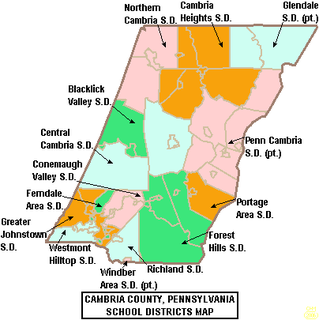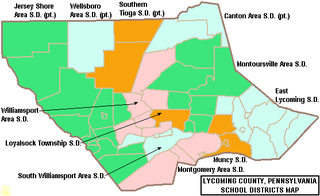Related Research Articles

A preschool, also known as nursery school, pre-primary school, or play school, is an educational establishment or learning space offering early childhood education to children before they begin compulsory education at primary school. It may be publicly or privately operated, and may be subsidised from public funds.

The No Child Left Behind Act of 2002 (NCLB) was a U.S. Act of Congress that reauthorized the Elementary and Secondary Education Act; it included Title I provisions applying to disadvantaged students. It supported standards-based education reform based on the premise that setting high standards and establishing measurable goals could improve individual outcomes in education. The Act required states to develop assessments in basic skills. To receive federal school funding, states had to give these assessments to all students at select grade levels.
The Early Childhood Education Act is the name of various landmark laws passed by the United States Congress outlining federal programs and funding for childhood education from pre-school through kindergarten. The first such act was introduced in the United States House of Representatives by Congresswoman Patsy Mink of Hawaiʻi in the 1960s. The theory behind the act is that the years before a child reaches kindergarten are the most critical to influence learning. Many children do not have access to early education before entering kindergarten. The goal of the act is to provide a comprehensive set of services for children from birth until they enter kindergarten.

The Elementary and Secondary Education Act (ESEA) was passed by the 89th United States Congress and signed into law by President Lyndon B. Johnson on April 11, 1965. Part of Johnson's "War on Poverty", the act has been the most far-reaching federal legislation affecting education ever passed by the United States Congress.

Upper Darby School District (UDSD) is a large public school district of approximately 12,000 students in Upper Darby Township, Delaware County, Pennsylvania. It consists of an 8.3-square-mile (21 km2) area including Upper Darby Township, Clifton Heights borough, and Millbourne borough. According to 2009 local census data, it serves a resident population of 90,000. In 2009, the district residents’ per capita income was $20,699, while the median family income was $51,965. In the Commonwealth, the median family income was $49,501 and the United States median family income was $49,445, in 2010. According to District officials, in school year 2007–08, Upper Darby School District provided basic educational services to 11,700 pupils.

The School District of Philadelphia (SDP) is the school district that includes all public schools in Philadelphia. Established in 1818, it is the 8th largest school district in the nation, by enrollment, serving over 200,000 students.

Springfield School District (SSD) is a midsized, suburban, (K-12th) public school district located in Springfield Township, Delaware County. It also serves the neighboring Morton Borough in Pennsylvania. The district is one of the 500 public school districts of Pennsylvania. Springfield School District encompasses just 7 square miles (18 km2). According to 2000 federal census data, it served a resident population of 26,392. By 2010, the district's population increased to 27,515 people. The educational attainment levels for the Springfield School District population were 95.1% high school graduates and 38.6% college graduates. In the 2010 census, the median household income was $87,878 compared to $52,267 in Pennsylvania. The percent of families in poverty was 3.0; the percent of all people in poverty was 3.9; the percent of people under 18 years in poverty was 6.0.

The Altoona Area School District is a large, urban, public school district based in Altoona, Pennsylvania. The school district encompasses 59.6 square miles (154 km2) which includes all of Altoona, Logan Township and a small portion of Tyrone Township. According to 2000 federal census data, it serves a resident population of 63,248. Per District officials, in school year 2007-08 the Altoona Area School District provided basic educational services to 7,946 pupils. The District employed 569 teachers, 557 full-time and part-time support personnel, and 36 administrators. Altoona Area School District had a student body of approximately 8,000 in 2000, it was the 18th largest school district in Pennsylvania. It is one of the largest employers in Blair County with a staff of over 1,500. In 2002, the Altoona Area School District achieved its long-term goal of becoming ISO 9001 certified. It was the fifth school district in the United States to achieve this designation. AASD received more than $51.7 million in state funding in school year 2007-08.

The Cocalico School District is a small, suburban public school district located in Lancaster County, Pennsylvania in the United States. The school district covers the boroughs of Denver and Adamstown and East Cocalico Township and West Cocalico Township. Cocalico School District encompasses approximately 51 square miles (130 km2) square miles. According to 2008 local census data, it served a resident population of 21,095 people. Per 2011, US Census Bureau data, it serves a resident population of 21,115 people. The educational attainment levels for the Cocalico School District population were 80.9% high school graduates and 16% college graduates. In 2009, the district residents’ per capita income was $20,736, while the median family income was $54,850. In the Commonwealth, the median family income was $49,501 and the United States median family income was $49,445, in 2010. In Lancaster County, the median household income was $54,765. By 2013, the median household income in the United States rose to $52,100.

The Lakeland School District is a small, rural, public school district located in northern Lackawanna County, Pennsylvania. It comprises the boroughs of Jermyn and Mayfield and the townships of Carbondale, Greenfield, and Scott. It was organized June 30, 1968 as a jointure among the three districts previously serving the five municipalities. Lakeland School District encompasses an area of 66.2 square miles (171 km2). Lakeland School District attendance area had a population of 11,966, according to the 2000 federal census. By 2010, the district's population increased to 12,097 people. The educational attainment levels for the School District population were 91.8% high school graduates and 24.7% college graduates. The district is one of the 500 public school districts of Pennsylvania.
Lakeville Elementary School is an American elementary school that was named a 2009 Blue Ribbon School of Excellence, the US Department of Education's highest award. It is located in The Village of Lake Success, serving students in grades 1 through 5 as well as kindergarten. Kindergarten and Pre-Kindergarten classes are taught at Parkville School, which is located in the nearby town of New Hyde Park.

Penn Cambria School District is a small, rural, public school district located in Cambria County, Pennsylvania. The district serves the boroughs of Ashville, Cresson, Gallitzin, Lilly, Loretto, Sankertown and Tunnelhill in both Blair County and Cambria County. As well as the townships of Allegheny, Cresson, Dean, Gallitzin, Munster, and Washington. Penn Cambria covers 108 square miles (280 km2) in east-central Cambria County. According to 2000 federal census data, Penn Cambria School District served a resident population of 16,744. By 2010, the district's population increased to 17,359 people. The educational attainment levels for the School District population were 88.8% high school graduates and 14.9% college graduates. The district is one of the 500 public school districts of Pennsylvania.

The Chichester School District (CSD) is a suburban public school district located in southeastern Delaware County, Pennsylvania. It encompasses approximately 10 square miles (26 km2), covering the Boroughs of Marcus Hook, Trainer, Lower Chichester Township, and Upper Chichester Township in Delaware County. According to 2000 federal census data, Chichester School District serves a resident population of 24,648. In 2009, the district residents’ per capita income was $20,972, while the median family income was $57,240. In the Commonwealth, the median family income was $49,501 and the United States median family income was $49,445, in 2010. According to District officials, in school year 2007–08 the Chichester School District provided basic educational services to 3,571 pupils through the employment of 302 teachers, 239 full-time and part-time support personnel, and 27 administrators. Chichester School District received more than $16.2 million in state funding in school year 2007–08.

The Wilkinsburg School District is a small, urban public school district serving the mostly African American community and Pittsburgh suburb of Wilkinsburg, Pennsylvania. The district encompasses approximately 3 square miles (7.8 km2). According to 2000 federal census data, it served a resident population of 19,196. By 2010, the district's population declined to 15,933 people. The educational attainment levels for the Wilkinsburg Borough School District population were 90% high school graduates and 28.5% college graduates.

The Kennett Consolidated School District is a large, suburban, public school district serving portions of Chester County, Pennsylvania. It is centered on the borough of Kennett Square and also incorporates Kennett Township, New Garden Township, and the southern portion of East Marlborough Twp. The district encompasses approximately 35 square miles (91 km2). According to 2000 federal census data, it serves a resident population of 27,124. According to District officials, in school year 2007-08 the KCSD provided basic educational services to 4,128 pupils. It employed: 320 teachers, 207 full-time and part-time support personnel, and 16 administrators. Kennett Consolidated School District received more than $10.1 million in state funding in school year 2007-08.

The Williamsport Area School District is a large, urban school district and one of several public school districts in Lycoming County, Pennsylvania, in the United States. The district is centered on the city of Williamsport and also serves the neighboring Lewis, Hepburn, Lycoming, Old Lycoming, and Woodward townships. The district encompasses approximately 98 square miles (250 km2). According to 2000 federal census data, it served a resident population of 44,192. By 2010, the District's population had declined to 41,757 people. The educational attainment levels for the Williamsport Area School District population were 85.5% high school graduates and 17.4% college graduates. The District is one of the 500 public school districts of Pennsylvania.

The St. Clair Area School District is a diminutive, suburban public school district in Schuylkill County, Pennsylvania. Centered on the borough of St. Clair, it also encompasses the boroughs of Middleport and New Philadelphia, plus the townships of Blythe Township, New Castle Township, and East Norwegian Township. The district is one of the 500 public school districts of Pennsylvania. Saint Clair Area School District encompasses approximately 48 square miles (120 km2). According to 2000 federal census data, it served a resident population of 7,020. By 2010, the US Census Bureau reported that the district's resident population declined to 6,695 people. The educational attainment levels for the St. Clair Area School District population were 82.6% high school graduates and 9.8% college graduates.
Chester Community Charter School [CCCS], also known as Chester Community Charter, is a not-for-profit public charter school in Chester, Pennsylvania, serving the Chester-Upland School District, operated by Charter School Management, Inc., a for-profit company owned by Vahan Gureghian, a multimillionaire businessman and top Republican donor. The school provides full-day kindergarten through 8th grade. Students apply to attend and the school is open to students from the Delaware County and Philadelphia region. It describes itself as "dedicated to empowering students as learners through the development of a learning community". The school is governed by a six-member board of directors. The administration consists of a CEO, a deputy superintendent, a chief financial officer and a principal at each school building. CCCS operates two campuses; one located in Chester City, known as the East Campus and one located in Chester Township, known as the West Campus. Each campus contains multiple newly constructed school buildings. The school is a federally designated Title I school.
The highly qualified teacher provision is one of the goals of the No Child Left Behind Act (NCLB) of 2001. The term highly qualified teachers (HQT) comes from the original language of Title II of the No Child Left Behind Act. Title II of NCLB designates federal funds to educational agencies for the purpose of improving the student achievement through the professional development of highly qualified teachers and principals. To qualify for this funding, states must comply with a series of conditions stipulated in NCLB, and track their progress toward goals each state sets. Title II was originally known as the Eisenhower Professional Development Program, and has undergone several reauthorizations, though the original intent has remained relatively intact. The main goals of the highly qualified teacher provision is to ensure that every classroom is staffed by a teacher deemed "highly qualified" under conditions set by NCLB. As some point out, this section of NCLB is quite at odds with the general thrust of NCLB because it focuses on school inputs rather than student outcomes. The sections of NCLB designated to HQTs allocates the majority of the funds to the states and does not clearly define at the federal level what is and what is not a highly qualified teacher, allowing for more local definitions of this term. This provision has come under much scrutiny, as it is up to states to decide how to measure highly qualified, and states are not holding their teachers to the same level of rigor across the country. Since its reauthorization in 2001, Title II has yet to reach its stated goal of ensuring that 100% of teachers in public schools in the United States are highly qualified.

An elementary school is the main point of delivery of primary education in the United States, for children between the ages of 6–11 and coming between pre-kindergarten and secondary education.
References
- ↑ About reading first
- ↑ Conflicts of interest, see
- ↑ Support for reading first
- ↑ Support for reading first
- ↑ Study Questions 'No Child' Act's Reading Plan, by Maria Gold, The Washington Post , May 2, 2008
- ↑ Kathleen Kennedy Manzo, Reading First Doesn't Help Pupils 'Get it', Education Week , May 7, 2008